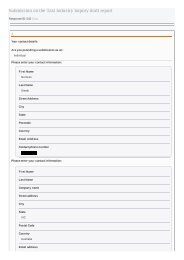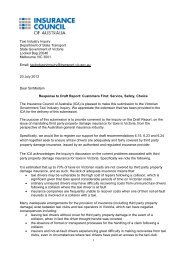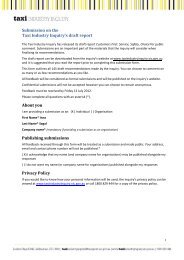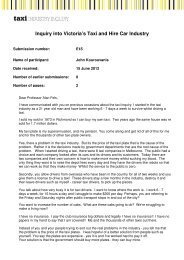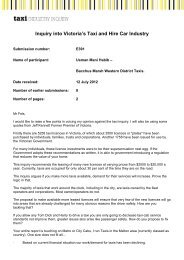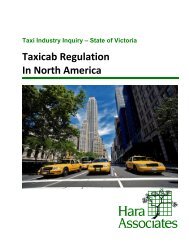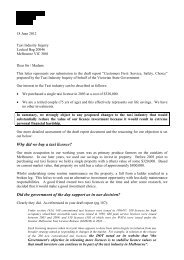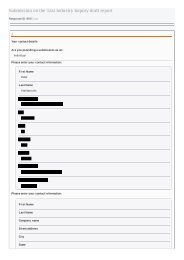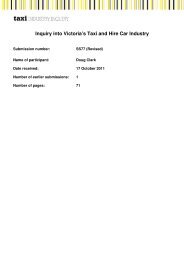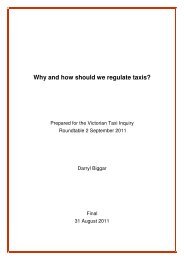Part D â Understanding and improving industry performance (PDF ...
Part D â Understanding and improving industry performance (PDF ...
Part D â Understanding and improving industry performance (PDF ...
Create successful ePaper yourself
Turn your PDF publications into a flip-book with our unique Google optimized e-Paper software.
• It exposes taxi operators to a degree of risk because<br />
they cannot readily pass on changes in dem<strong>and</strong><br />
<strong>and</strong> supply conditions (such as changes in LPG<br />
prices) to consumers.<br />
• The regulator may set fares at a level that is too high<br />
or too low, with this risk accentuated by the limited<br />
amount of information that is provided by <strong>industry</strong> on<br />
costs <strong>and</strong> revenues.<br />
Of these issues, the last has caused the inquiry particular<br />
concern. It is obvious that fare regulation is not likely to<br />
lead to efficient behaviours if the fare-setting authority<br />
cannot collect accurate data on:<br />
• The number of taxi trips <strong>and</strong> the distribution of these<br />
trips across distances, times <strong>and</strong> geographies<br />
• Revenue earned <strong>and</strong> the distribution of this revenue<br />
• Vehicle utilisation data across times of the day <strong>and</strong> of<br />
the week<br />
• Waiting times for consumers at ranks <strong>and</strong> for<br />
booked work<br />
• The costs of vehicles <strong>and</strong> other important inputs<br />
• The elasticity of dem<strong>and</strong> for different kinds of taxi<br />
users <strong>and</strong>/or trips<br />
• Driver remuneration arrangements.<br />
All of these factors should be relevant to determining<br />
whether fares are likely to be set at an efficient level (which<br />
allows an efficient operator to recover costs, inclusive of<br />
a reasonable return) <strong>and</strong> establishing fare structures that<br />
promote efficient usage of taxis.<br />
These concerns are particularly pertinent for taxis in<br />
country areas. Each of these markets has individual<br />
characteristics that are difficult to account for in a fare<br />
modeling exercise. These concerns are heightened by<br />
the nature of dem<strong>and</strong> in these markets. Pre-booked work<br />
is far more prevalent, operators rely on repeat business<br />
<strong>and</strong> strong relationships with the local community, <strong>and</strong><br />
there are opportunities for greater service innovation. As<br />
discussed in chapter 20, there may be a good case here<br />
for reducing the regulatory burden on operators in country<br />
areas by allowing them to set their own fares.<br />
As a general point, the Commission notes that not only<br />
is there very little reliable information or data relating to<br />
previous fare adjustments but this observation applies<br />
equally to <strong>industry</strong> data more generally. This has<br />
presented considerable difficulties for the Commission<br />
over the course of this review <strong>and</strong> would be expected<br />
to hinder the efficient administration of the taxi <strong>industry</strong><br />
<strong>and</strong> future decision-making of the Victorian Taxi <strong>and</strong><br />
Tow Truck Directorate <strong>and</strong> Government, particularly in<br />
light of the recommendations of this review. 106<br />
The ESC repeated this observation in 2008:<br />
At present very little information is collected from<br />
<strong>industry</strong> participants, <strong>and</strong> this has presented ongoing<br />
policy <strong>and</strong> regulatory <strong>and</strong> policy problems. 107<br />
It was expected that <strong>industry</strong> accreditation processes,<br />
which required certain data to be compiled by NSPs <strong>and</strong><br />
operators, would improve data availability for regulatory<br />
purposes. The inquiry has found that it has been<br />
unsuccessful in fulfilling this objective.<br />
The inquiry makes further findings about how fares<br />
should be regulated in chapter 20 <strong>and</strong> information<br />
gathering in chapter 2.<br />
Inquiry findings<br />
è There are grounds to regulate taxi fares where<br />
rank <strong>and</strong> hail work is common.<br />
è Regulations that prevent fare competition<br />
are potentially costly <strong>and</strong> offer no<br />
discernable benefits.<br />
è Insufficient data is collected to effectively<br />
regulate taxi fares. This must be addressed as<br />
a matter of priority.<br />
Ultimately, the lack of information available has constrained<br />
the inquiry in considering submissions of issues around<br />
fare levels <strong>and</strong> fare structures. Again, this is an issue that<br />
has bedevilled previous taxi reviews. The ESC noted in<br />
2005 that:<br />
106 ESC (2005), Op. Cit., p.2<br />
107 ESC (2008b), p.190<br />
<strong>Underst<strong>and</strong>ing</strong> <strong>industry</strong> <strong>performance</strong> CUSTOMERS FIRST 215




